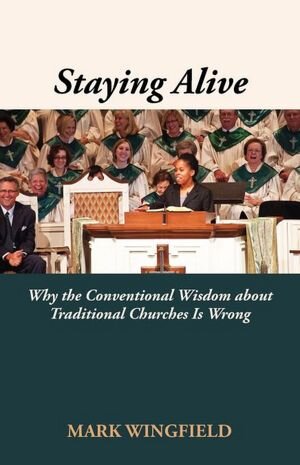Mark Wingfield, Staying Alive: Why the Conventional Wisdom About Traditional Churches Is Wrong (TCP Leadership Series). Chalice Press, 2012.
Referenced in: Church Leadership Strategies – Traditional Church Renewal
LifeandLeadership.com Summary
This is another excellent work from The Columbia Partnersip Leadership Series. The focus here is traditional churches.
Mark Wingfield summarizes the gist of his book:
Contrary to the macro patterns of denominations, on the local level there are many untold success stories of traditional Protestant churches that not only are surviving but thriving. Somehow, in the midst of all the handwringing over failing churches, these healthy models have been overlooked.
Wingfield set out on a six-week sabbatical to discern the best practices of fifteen of these churches from six different denominations. Here are a few distinguishing marks of these congregations:
- Most had traditional worship even if they offered contemporary worship options.
- Most began with the traditions of the church and invited people to join them, as oppossed to the seeker-sensitive model that ascertains felt needs and crafts attractive religious experiences.
- Most had program-driven, age-graded ministries and intentional missions programs rather than being worship-driven.
- Most followed an evangelical bent of primarily conservative theology and all male pastors.
- There was no scientific strategy in selecting the congregations for study, and although fairly diverse geographically and denominationally, they were predominantly ethnically Anglo.
Regarding his research method, Wingfield says:
The research interviews focused on two broad questions: (1) In the religious ecosystem of your community, what is the role your church plays? Or why do people choose your church over any other church in town? (2) What do you perceive to be some of the best practices of your congregation that might be instructive to other churches?
His interviews led to this conclusion: “The demise of traditional Protestant congregations has been greatly exaggerated.”
In a summary article, Wingfield highlighted some of the most important things he learned, each of which is expanded signficiantly in the book:
- Successful traditional churches have figured out who they are and are happy with it.
“The unreported reality is that throwing out tradition and trying to go contemporary has failed in as many or more established churches as it has succeeded. These failures, I believe, come from pastors leaving their core congregations behind in the change and from congregations attempting to be something they do not have the resources to become.”
- Successful traditional churches are intentional about what they do. This is especially true about intentional planning, preparation, and evaluation for Sunday worship assemblies.
- Successful traditional churches value excellence in everything they do. Successful traditional churches understand the level of expectation has risen, and limit themselves to do only the things they can do well. For most, this begins in the pulpit, and then music, regardless of style.
- Successful traditional churches employ creativity even in traditional worship. “Traditional Protestant churches are succeeding today when they approach tradition creatively and not as obligatory exercises in ritualistic practice.”
- Successful traditional churches take risks. – “A difference between these churches and unhealthy congregations is that the healthy churches were able to dust themselves off, learn from what didn’t work and move on to try something else. Their DNA allows for flexibility and adaptability.”
This is an emboldening call for traditional church leaders to take heart, stop “copy-cat” approaches, abandon self-pity and defeatism, and enter the future hopefully.
From the Publisher
“Unless you start a contemporary service, your church will die.”
These words have led to the near-death of many a Protestant church in America in the past 30 years as the fear of being left behind has paralyzed clergy and lay leaders alike.
The conventional wisdom says it’s not possible to thrive today as a traditional congregation—whether “traditional” means worship style or program structure. A journey across America to look for best practices of thriving traditional congregations proves that the conventional wisdom is wrong. Here are 16 examples of “traditional” churches that remain vibrant.
From the Author:
If you’re a pastor or church leader who’s ever wondered if it’s possible to succeed today as a “traditional” Protestant church, this book is for you. If you want to know practical ideas that are working in Protestant churches in America—churches that are driven by traditional programs and structures—this book is for you.
This book is the product of a six-week sabbatical research project that took me from Dallas, Texas, to New York City, Connecticut, Houston, Chicago, Indianapolis, Iowa, Los Angeles, San Diego and Atlanta to look at Presbyterian, Lutheran, Methodist, Baptist, Congregational and Reformed churches. My goal was to find out what best practices are sustaining healthy traditional congregations.
About the Author
Mark Wingfield is a veteran religious journalist who is enjoying a second career in local church ministry. He serves as associate pastor of Wilshire Baptist Church in Dallas, Texas, which has been cited as a model congregation for creativity, excellence and intentionality. He has written thousands of articles for national news outlets, magazines and a variety of newspapers. In Staying Alive, he combines his skills as a veteran journalist with his experience as a parish minister to make a case that reports of the death of traditional congregations are premature.
***For additional information on this resource, including reviews, click the bookstore links. Check the reference at page top or the links below for resource guides on related topics.***
See Resources on Over 100 Areas of Ministry Leadership:


